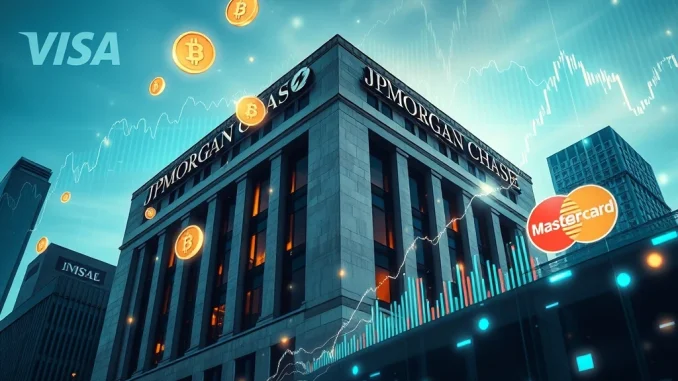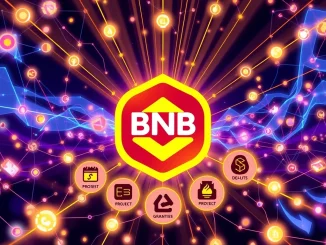
In a move that signals a seismic shift in the financial landscape, JPMorgan Chase has unveiled a strategic pivot towards deeply integrating stablecoins into the very fabric of traditional financial systems. For anyone tracking the evolution of money and the burgeoning world of digital assets, this announcement is a game-changer. It highlights a growing recognition by established institutions like JPMorgan that stablecoins aren’t just a fleeting trend but a powerful tool poised to redefine how we transact, manage assets, and conduct cross-border payments. The firm’s commitment to exploring new opportunities within the cryptocurrency sector through robust JPMorgan stablecoin initiatives underscores a broader industry trend towards bridging the gap between decentralized finance (DeFi) and conventional banking.
The JPMorgan Stablecoin Leap: Bridging TradFi and Digital Assets
JPMorgan Chase’s recent announcement, made on July 15, 2025, marks a significant commitment to leveraging stablecoin technology. This isn’t just about dabbling; it’s about fundamentally enhancing financial services, streamlining cross-border transactions, and expanding tokenized asset offerings. CEO Jamie Dimon, often a cautious voice on crypto, has openly supported this initiative, stating the firm’s aim to ‘explore new opportunities within the cryptocurrency sector through stablecoin technology.’ This declaration underscores JPMorgan’s strategic intent to build a robust bridge between the crypto world and traditional finance.
The move aligns with a broader industry embrace, as other major players like Bank of America are also signaling strong interest in stablecoin products. JPMorgan’s internal analysis projects a substantial $75 billion increase in stablecoin supply, driven by the escalating demand for instant, low-cost payments and efficient collateral management solutions. This projected growth underscores the increasing utility and acceptance of stablecoins in a variety of financial applications.
Unpacking the Stablecoin Integration Phenomenon: Why $27 Trillion Matters
The sheer scale of stablecoin activity provides compelling evidence of their disruptive potential. In 2024 alone, stablecoins processed a staggering $27 trillion in transaction volume. To put that into perspective, this figure surpasses the combined capabilities of payment giants Visa and Mastercard. This record-breaking crypto transaction volume highlights stablecoins’ critical role as a robust bridge between decentralized finance (DeFi) and traditional markets. Their ability to facilitate rapid, low-cost settlements positions them as a transformative force across various sectors, including remittances, international trade, and DeFi applications.
Key drivers behind this massive growth include:
- Efficiency: Stablecoins offer near-instantaneous settlement times, drastically reducing the delays associated with traditional banking rails.
- Cost-Effectiveness: Transaction fees for stablecoin transfers are often significantly lower than conventional cross-border payment methods.
- Accessibility: They provide a global, 24/7 payment infrastructure, enabling financial inclusion for underserved populations.
- Collateral Management: Their stability makes them ideal for collateralizing loans and other financial instruments within DeFi.
This unprecedented volume demonstrates the practical scalability and growing utility of stablecoins, making their deeper stablecoin integration into mainstream finance not just plausible, but increasingly inevitable.
Navigating Regulatory Waters for Traditional Finance Crypto
The successful integration of stablecoins into traditional finance hinges critically on clear and supportive regulatory frameworks. Recent legislative efforts, such as the ‘Genius, Clarity, and Anti-CBDC acts,’ aim to facilitate institutional participation by establishing clearer guidelines for stablecoin operations. JPMorgan analysts emphasize that regulatory collaboration is essential to address inherent risks and ensure compliance. However, the firm’s internal reports acknowledge that a specific timeline for complete policy alignment remains uncertain. This cautious approach reflects the complex interplay between innovation and the need for robust oversight.
For traditional finance crypto initiatives to flourish, regulators must:
- Define clear legal classifications for stablecoins.
- Establish robust reserve backing requirements to ensure stability.
- Develop cross-border compliance standards to prevent illicit activities.
- Foster an environment that encourages innovation without stifling it through excessive fees or restrictive policies.
The path to full integration requires a delicate balance, ensuring consumer protection and financial stability while allowing the technology to reach its full potential.
JPMorgan’s Broader Digital Asset Strategy
JPMorgan’s strategic experiments extend far beyond stablecoins, forming a comprehensive digital asset strategy. The bank has actively explored innovative applications, including lending against clients’ cryptocurrency holdings. This demonstrates a willingness to engage with crypto assets beyond just payment mechanisms. Furthermore, JPMorgan has been a vocal supporter of broader tokenization initiatives, notably backing Goldman Sachs’ efforts to digitize cash. These moves reflect a calculated approach to capitalizing on the growing acceptance of digital assets while simultaneously navigating inherent challenges such as interoperability and institutional resistance.
However, this journey isn’t without its hurdles. For instance, the bank recently suspended the onboarding of Gemini, a prominent crypto exchange. This incident highlights ongoing tensions between traditional financial systems and crypto platforms, often stemming from disagreements over data access, fee structures, and differing operational philosophies. Such instances underscore the complexities involved in forging seamless connections between two distinct financial paradigms.
The Future of Crypto Transaction Volume: Opportunities and Obstacles
While JPMorgan acknowledges stablecoins’ immense potential to revolutionize liquidity management and cross-border settlements, the path forward is not without its challenges. Critics frequently point to unresolved regulatory uncertainties, particularly concerning governance models, the transparency of reserve backing, and complex cross-border compliance issues. The firm’s cautious optimism is tempered by these significant concerns, with analysts stressing the imperative for a collaborative ecosystem. This ecosystem must foster innovation while ensuring it is not stifled by prohibitive fees or overly restrictive policies.
The integration of stablecoins into traditional finance could fundamentally redefine asset management, enabling seamless transfers between digital and fiat ecosystems. JPMorgan’s internal analysis suggests stablecoins may serve dual roles: as efficient payment tools and as reliable collateral. This addresses long-standing inefficiencies within legacy financial systems. However, the firm stresses that achieving this transformative vision requires a careful balance between technological innovation, rigorous regulatory scrutiny, and practical operational feasibility. The impressive crypto transaction volume of $27 trillion in 2024 serves as a clear indicator of stablecoins’ current scalability and future potential.
JPMorgan’s projections are grounded in tangible market data, not speculative forecasts. The bank’s strategic alignment with broader tokenization trends further underscores its conviction in the long-term relevance of digital assets within established financial frameworks. As stablecoins continue to mature and gain wider acceptance, their role in shaping the future of global finance will only grow.
Frequently Asked Questions (FAQs)
What is JPMorgan’s new stablecoin strategy?
JPMorgan’s new strategy involves deeply integrating stablecoins into traditional financial systems to enhance services, streamline cross-border transactions, and expand tokenized asset offerings. They aim to leverage stablecoin technology to bridge conventional banking with the digital asset world.
How much stablecoin transaction volume was processed in 2024?
In 2024, stablecoins processed a record $27 trillion in transaction volume. This figure notably surpasses the combined capabilities of traditional payment networks like Visa and Mastercard, highlighting the significant growth and adoption of stablecoins.
What are the main benefits of stablecoin integration for traditional finance?
Stablecoin integration offers several benefits, including faster and lower-cost cross-border payments, enhanced liquidity management, efficient collateral management solutions, and the ability to seamlessly transfer assets between digital and fiat ecosystems. They act as a crucial bridge between DeFi and traditional markets.
What regulatory challenges do stablecoins face?
Stablecoins face several regulatory challenges, including uncertainties around governance models, transparency and verification of reserve backing, and establishing consistent cross-border compliance standards. Clear legislative frameworks and collaborative regulatory efforts are crucial for their widespread adoption and stability.
Does JPMorgan support other digital asset initiatives?
Yes, beyond stablecoins, JPMorgan has explored other digital asset initiatives. These include considering offering loans backed by clients’ cryptocurrency holdings and supporting tokenization efforts, such as Goldman Sachs’ push to digitize cash. This reflects a broader digital asset strategy.
Why did JPMorgan suspend Gemini’s onboarding?
JPMorgan’s suspension of Gemini’s onboarding highlights ongoing tensions between traditional financial systems and crypto platforms. These tensions often arise from disagreements over data access, fee structures, and differing operational philosophies, indicating the complexities of integrating these two distinct financial paradigms.



